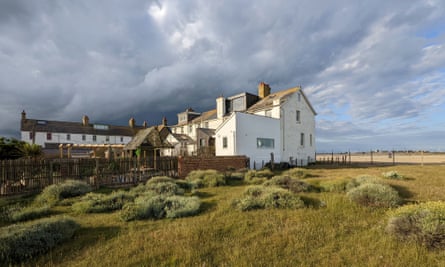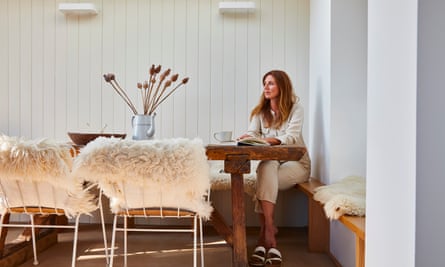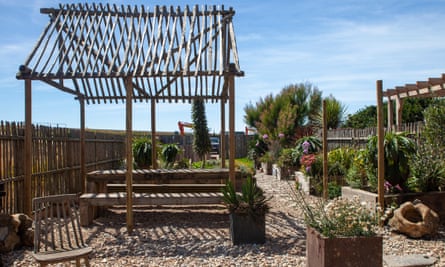
Four miles along the coast from Rye at Jury’s Gap sits a cluster of nine coastguard cottages. Built in two short, perpendicular terraces, the white brick facades and lichen-covered roofs are a familiar sight on Britain’s coastline. “The design of these cottages was very considered,” explains Marta Nowicka, who owns an end terrace. “These are one of the original live-work spaces, so it’s a very practical space.”
Nowicka’s cottage faces out to sea, but she is quick to add that the setting is far from idyllic. The cottages are on the edge of an MoD firing range – what Nowicka calls a “no-go area”. This creates a “tension” that appealed to her. She’s a London-based interior architect who purchased her cottage in 2010.
Nowicka and her late husband got to know Rye in the 1990s, having been drawn to the town’s artistic community, the expansive views and the rigours of year-round sea swimming. When Nowicka’s father died, they used a small inheritance to buy a bolthole by the sea. “It was in terrible condition,” Nowicka recalls. “It hadn’t been touched since the 60s and the entire place had been vandalised. The floorboards had been ripped up and all the copper piping removed. The windows and sanitaryware were smashed, the walls graffitied and there was rubble and rubbish everywhere. It was actually quite creepy. But, underneath it all, it was a fantastic canvas to work with,” she says.
A slow, budget-conscious renovation ensued. Nowicka commuted to the site every day, overseeing the installation of new electrics and plumbing. In keeping with its utilitarian aesthetic, she added a stainless-steel Ikea kitchen and painted almost every wall white.
For more than a decade, Nowicka and her son, Lucas, spent weekends and holidays at the cottage. “I was constantly shattered from having too much fun there,” she recalls. “It was just so exciting to have this space – we wanted to share it with everyone.” When Lucas reached school age, Nowicka decided to live there permanently. “It was a challenge,” she admits. “The weather is quite extreme and the cottages are incredibly isolated.” After giving it a go, she eventually decided to spend the winter in London and the milder months on the coast. When the property wasn’t in use, she rented it out via her online rental platform, DOM Stay & Live.

After 10 years of use, Nowicka decided it was time to undertake a second phase of renovation. “An open kitchen and dining area was really the missing ingredient…”
Nowicka sketched out plans for a new space that incorporated an existing sun terrace. “I’ve stayed true to the original proportions of the house and created a dining space connected to the living area and the kitchen via open apertures.”
The result is a lofty space with a neat wet room at one end and a double-height void with built-in storage. In the centre of the space is Nowicka’s gnarled dining table, which she inherited from her father, who found it in an outbuilding while working on a historic estate in Poland.

“The dining table is medieval: it comes with 500 years of stories,” Nowicka explains. “My whole childhood was spent around that table – a lot of good times have been had there.” The patinated wood is juxtaposed with steel Antelope chairs, designed for the Festival of Britain by Ernest Race and softened with sheepskins.
Throughout the pared-back interior, Nowicka has embraced a “mish-mash of styles”. In one of the two living rooms hangs a Victorian clock taken from her parents’ offices on London’s Brompton Road. (Her mother was a fashion designer; her father an architect.) In another room, an incongruous chandelier from the former offices of the Spectator glistens above a wingback chair. Artwork from the 60s and 70s lends a retro vibe to the walls.
From the first floor landing, a steep ship’s ladder climbs up to an attic bedroom encased in tongue and groove. The handrail is a mooring rope. “There should really be a monkey knot in the end,” she admits, “only nobody knows how to tie one!”

There are two bedrooms and a bathroom on the first floor and two more bedrooms and a terrazzo-clad wet room on the lower-ground floor. “It feels very spacious,” she says. “Everybody has their own space to retreat to, but now there is room for us all to come together.”
The recent renovations have radically changed Nowicka’s experience of the cottage. Instead of coming down for the weekend, Nowicka finds it hard to leave. “When my local friends came for our first dinner this summer, they all said: ‘This is what has been missing for all those years!’ It’s turned the entire space from nice to perfect.”



